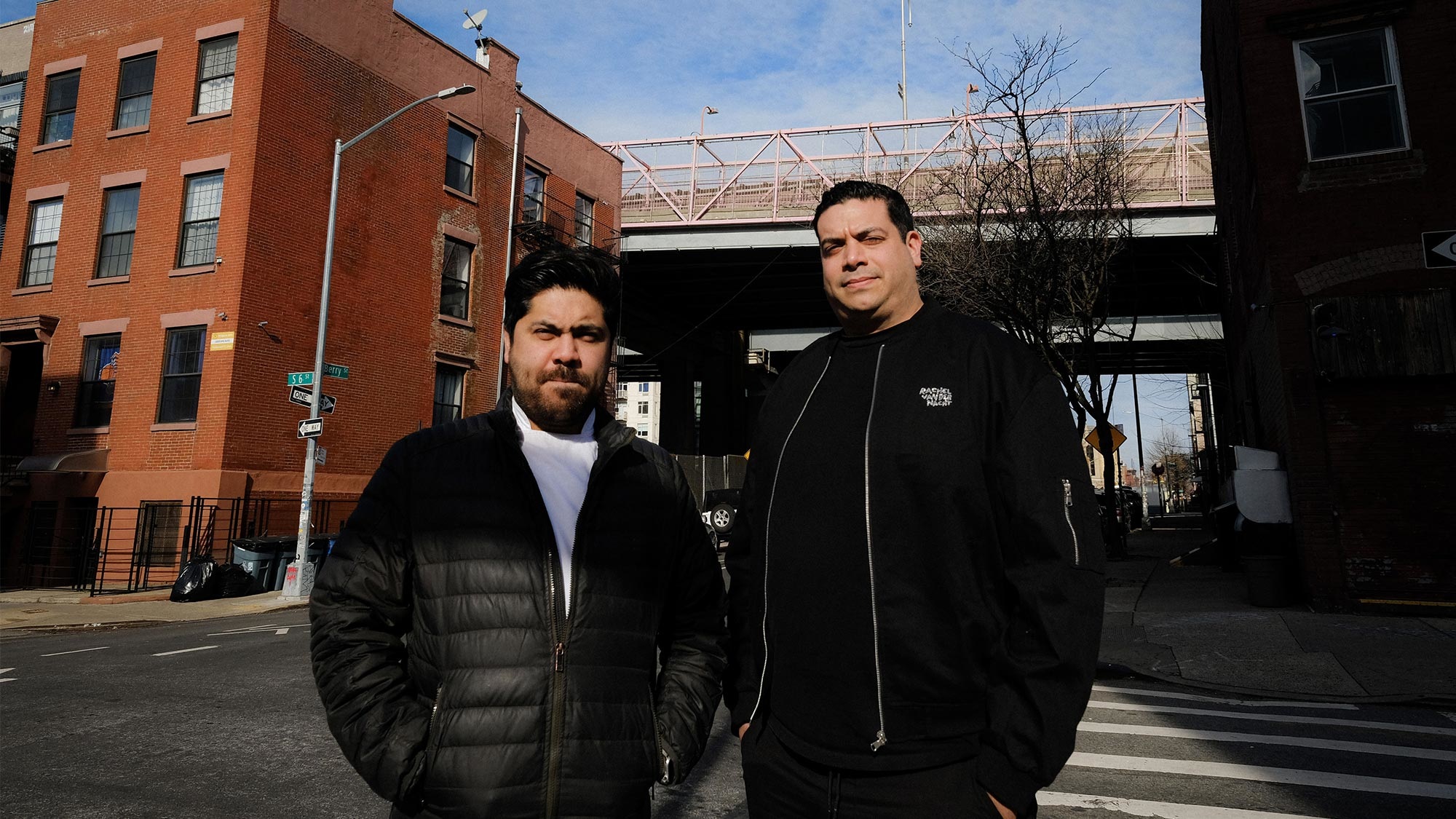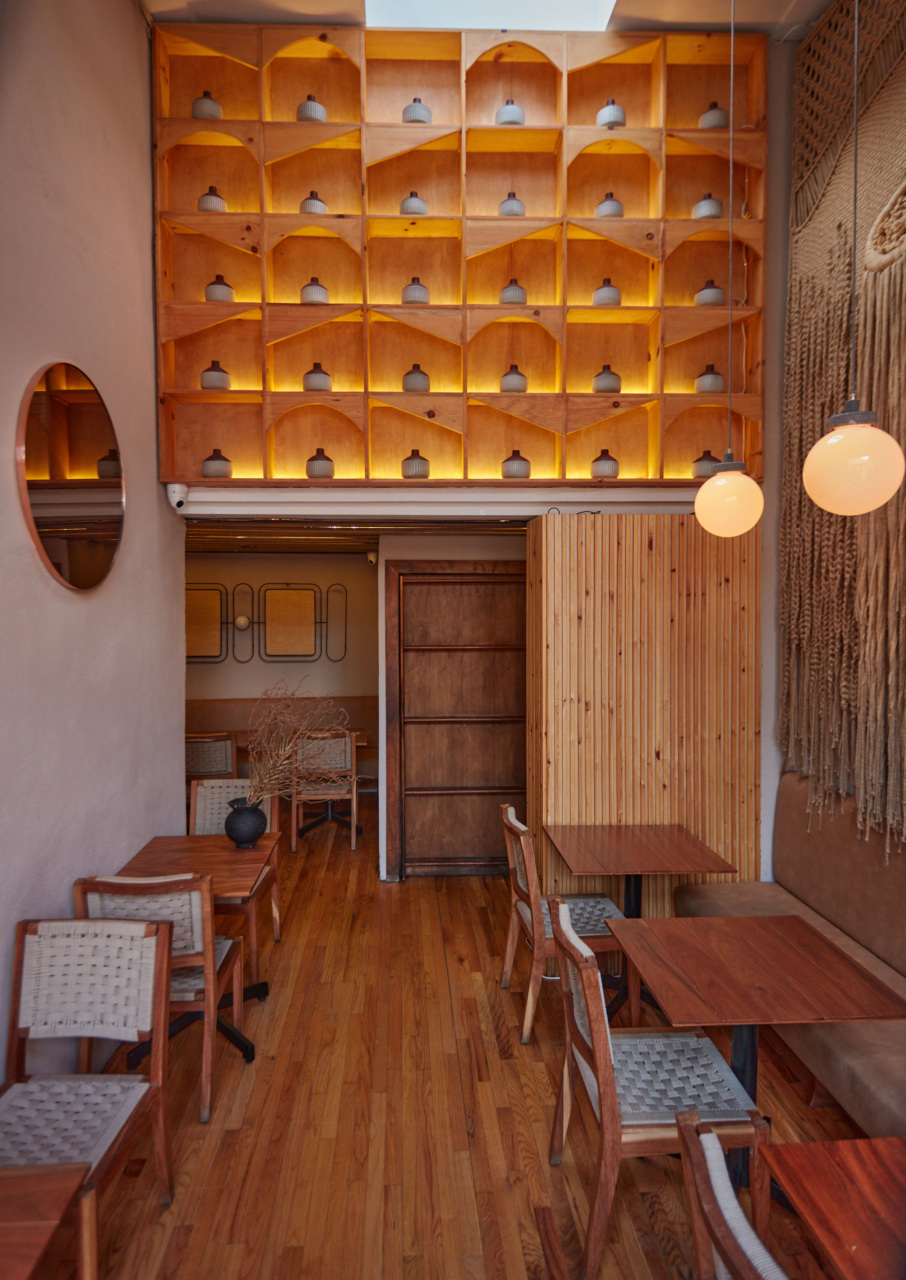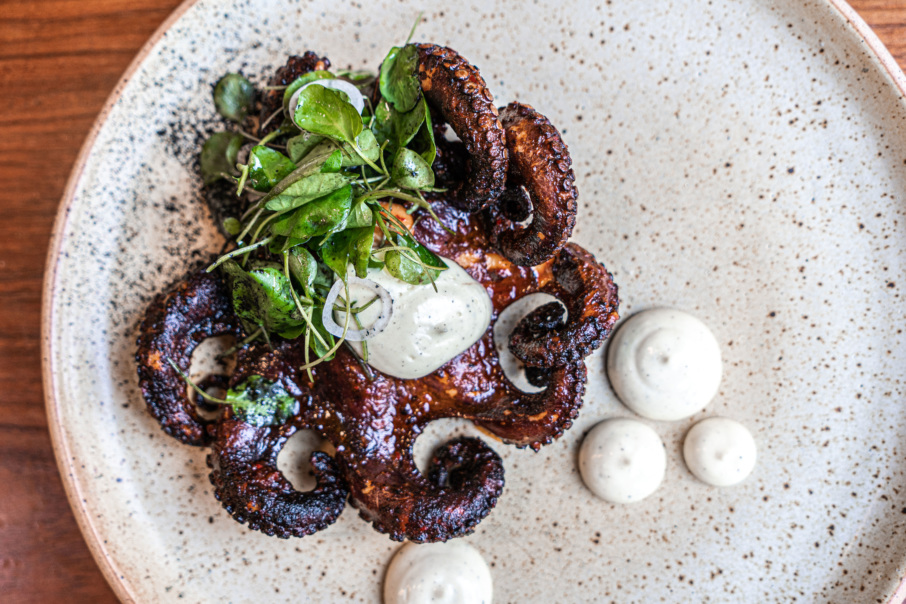
A Long Road to Success: How the Owners of Aldama Found Acclaim and Community in New York City
Any first-time restaurant owner in New York City is bound to have a laundry list of unimaginable setbacks they’ve had to surmount. But as first-time restaurant owners in New York City during a pandemic, no less, Christopher Reyes and Gerardo Alcaraz faced a whole new set of them. It’s something that you wouldn’t even begin to guess if you’ve been lucky enough to snag a Resy at Aldama, their high-energy, perpetually packed Mexican bar and restaurant in Williamsburg.
Lauded by the press as the next best thing to a late-night Mexico City hot spot without the airfare (by the way, Reyes and Alcaraz would like to rectify the Mexico City association, but more on that later), Aldama has dazzled the city with its freshly shaved-off-the-trompo tacos, vegan mole, and seafood plates like campechana.
Curious to know how it all happened, we chatted with Reyes, with Alcaraz by his side, about the long year it took to open the restaurant, the community of fresh new Mexican restaurants popping up all over the city, and what the future looks like.
The following interview has been edited for length and clarity.
Resy: Let’s start at the very beginning. How did you two meet?
Christopher Reyes: Gerardo [Alcaraz] and I met eight years ago at The Black Ant, a Mexican restaurant in the East Village, when it first opened. Gerardo was a line cook then, and I was the bartender. We grew a connection during the first few weeks we started working together, and we stayed connected throughout the years.
I went on to work at several different places: the NoMad, Maison Premiere, and Cosme. Gerardo went back to Mexico for a while, came back, and went to the Black Ant to be the executive chef. There were several other things. But then, during the pandemic, Gerardo and I were like, “We can’t work for anybody anymore.” We felt like we were capable of doing something on our own, and that’s what led us to opening Aldama.
So, Aldama was a project born out of the pandemic?
Prior to the pandemic, we didn’t have plans of opening anything anytime soon. But during the pandemic, Gerardo and I started selling to-go cocktails and burritos at Ponyboy, and the response was overwhelming. I looked at him one day and said, “I think we should get a little taco shop, somewhere where we pay $3,000 a month. You make tacos, I’ll make some drinks, and let’s see where that takes us.”
We started shopping around for little spaces. And one day, I was walking in front of this place called Loosie Rouge that had closed, and the landlord just happened to be there. I asked, “Hey, are you renting that space?” And he said, “Give me X amount of money in the next three days, and I’ll give you the lease.”
I went to Gerardo, running, and I said, “You have got to see this place, it’s great!” And Gerardo told me, “You know what, let’s do it. Let’s just figure this out.” We didn’t even have that much money. We just started working at Ponyboy, to the point where we couldn’t anymore, we were so tired. We almost opened three different times, but the city would shut down and so we couldn’t. We couldn’t do a lot of things. But we made it. The restaurant is in excellent shape; it’s packed all the time, and we’ve gotten great press.
Around what time did you get your lease?
We had the lease on July 1, 2020, and we were able to open July 1, 2021. Yeah, believe me, it’s been the biggest sacrifice any of us ever made. Emotionally draining. But it was worth it.
Can you walk us through what happened during that gap year, from the time you got the lease to the opening?
When we took over the place, we didn’t have any architectural plans. We didn’t have an interior designer; we didn’t have money! My old friend Paulette [Ramírez] is an architect and an interior designer from Guadalajara. So, we reached out to her, and said, “Hey, do you think you could help us with this?” And she said, “Yes, let’s buy all the furniture from Mexico and build this great place.” It sounded amazing.

But little by little, the concept changed. First, we went from trying to sell tacos to doing something more upscale. We were getting all these crazy ideas. We would work 10 to 12 hours at Ponyboy where we were selling to-go. Gerardo was the porter, the cook, and the dishwasher. I would batch all the cocktails and take care of the window. Gerardo would work all day, then come to Aldama and help the contractor — who’s like 60 years old and can only walk with one leg — and help him demolish the place. We basically worked double shifts for eight months. It was brutal. The bills were piling up at Aldama, and we were thinking, oh my god, we’re not going to be able to do this. But we pushed through.
How did you refine your concept over that time?
Gerardo and I have a really good relationship outside of our business arrangement. We’ve been friends for many, many years. We would always get together and criticize other people’s food and be like, “Yo, we could do this way better!” [laughs].
Everyone in New York is infatuated with Oaxacan food. And we thought that there was so much more for people to try. Gerardo likes to cook seafood, aguachile, ceviche, and anything that’s kind of known as hangover food in Mexico, or street food.
It wasn’t something super difficult or planned out. It was organic. We would talk and ask ourselves, “What’s missing in New York?” You know, in Mexico, if it’s a Sunday and you’re with your family, you’re going to have a carne asada. And that’s how we made our 26-ounce rib eye with tortillas and salsas, to recreate the Sunday asado in Mexico. Things like that. Or asking, “What do you like to eat?” “I like to eat this.” “Alright, let’s try to do that!” Gerardo is very talented.
A lot of press and people are talking about Aldama as a Mexico City restaurant. Is that how you would define your cuisine?
To be honest, I don’t think we ever tell people we’re [doing] Mexico City food. We would consider the restaurant to offer street food at an elevated level from Central Mexico. There are certain things on the menu, like the carne cecina — a kind of dehydrated beef jerky cut very thin, which sells out every night — which is what Gerardo grew up eating in his city of León, Guanajuato. So, I don’t know where we got lost in translation with people calling us a restaurant from Mexico City [laughs]. But it’s fine; some of the things you can get in Mexico City, but it’s not just all from Mexico City.


Did you have any restaurant influences that inspired you when you were opening Aldama?
Absolutely. Cara de Vaca in Monterrey from Chuy Villarreal. La Docena Oyster Bar in Mexico City and Guadalajara. And Alcalde in Guadalajara, too. We wanted to have a hybrid of La Docena and Alcalde, two restaurants that Gerardo and I had the opportunity to go to together. They always sat in the back of our minds, like, if we ever opened something, this is what we should open.
Didn’t you have the folks from La Docena over for a guest chef dinner last year?
Yeah! We did both, we brought La Docena and Alcalde over.
Do you expect to do more of these chef collaborations?
Yeah, we just had El Gallo Altanero, which is the most popular agave bar in Guadalajara. For our anniversary, we’re bringing in Chuy from Cara de Vaca. He’s also the chef at Orinoco, which is the most famous taqueria in Mexico. This is going to be on June 6, on a Monday. We’re going to have Cara de Vaca from Monterrey in the kitchen, El Gallo Altanero doing agave pairings on the floor, and one big taco bar from Mexico City — they haven’t confirmed just yet, so I can’t really drop their name, but it’s going to be an awesome party.
I feel like New York’s always had this reputation of not having great Mexican food, which isn’t necessarily true.
Yeah, absolutely. There is great Mexican food in New York.
But it does feel like more and more modern Mexican restaurants are popping up and getting widespread acclaim.
Yeah! There’s a place that Gerardo and I love — he orders it every Monday. It’s this space on Roosevelt Avenue in Queens: Mariscos El Submarino. Alonso [Guzman, co-owner of Mariscos El Submarino], Gerardo, and I started our businesses at the same time. We met each other when no one would go to his restaurant, and we would go there and just complain back and forth about how we were so stupid about opening a restaurant during these hard times. And look at us now: He’s successful, and we’re doing amazing.
The guys from For All Things Good helped us tremendously. They helped us learn how to use a nixtamal machine to make the masa for our tortillas. Zach [Wangeman] from Sobre Masa helped a lot. There’s a lot of amazing Mexican restaurants in Brooklyn. To me, Claro has the best Mexican food in New York from Oaxaca, they’re amazing. Cosme, which is the king of the world for me, is the best Mexican restaurant outside of Mexico. ATLA does amazing things, too.
How do you see your place in New York’s modern Mexican food renaissance, so to speak?
I don’t think we define ourselves by where we stand. I think we’re doing things the way we best possibly can. And whatever we do, we stay true to it. We try not to be in constant competition with other restaurants, like worrying about what lists they’re on, or this and that. I think we’re doing things the right way, with the right ingredients, and respecting all of the Mexican restaurants that are nearby and doing different things. That’s where we stand.
What was your ambition with Aldama? What did you want diners to take away from your food?
We wanted them to feel like they were in Mexico. Like, this is real Mexico, not just like Tulum, and we’re not just serving quesadillas, burritos, or Tex-Mex food. We just wanted people to get a real taste of what people eat in their day-to-day lives in Mexico.


Can you tell us more about the bar program?
I worked at all of these really nice cocktail bars, but I didn’t want to do anything like that. We try our best to [make things] very clear to the guest — our cocktail program consists of three-to-four ingredient drinks. It’s very simple, with top-quality ingredients. Because if people go into a cocktail bar and they don’t understand some ingredients on the menu, [they could] be like, “Damn, I’m in a place where I don’t fit in.” So, everything on our menu is super chill, non-pretentious, and straightforward.
We’ve got classics like a Paloma, a quick margarita, a delicious michelada. We have cocktails with different spirits, because another thing that people [expect from] Mexican restaurants is that all their drinks should be made with mezcal and Tequila. And in Mexico, people don’t only drink that. Like, mezcal was for lower income people before it became so popular. But if you go to Mexico, the number one drink is Bacardi and Coke. Or a gin and tonic with 10 different fruits.
Food-wise, what was the hardest dish to develop?
Let me ask Gerardo. He says the vegan mole because it was very difficult to get the proper taste. Mole traditionally has chicken stock, which adds a tremendous layer of flavor, so it was difficult to nail it without that, especially because it also takes two days to make. It’s hard work. If someone misses something, you have to do it all over again.
What do you make of the recent uptick of vegan Mexican restaurants in New York?
Listen, people can do whatever they want. In Mexico, there’s this idea of what a good meal is, and it’s not vegetables. But, in this day and age, anyone can cook something delicious, with or without protein. I’m fine with that, and Gerardo, too. He originally wanted to make the mole non-vegan, and I said, “You have to remember that [more and more] people are turning vegan; we have to be able to accommodate [them].” So, we have a few vegan dishes. We always push to include more. But it’s not something we want to push too much for. I don’t think that’s the best way to represent Mexico.
Is vegan food a trend that’s happening in Mexico?
No, absolutely not. I haven’t seen anything vegan in Mexico. And I don’t think it’s going to be there for a long time. Vegetarian restaurants, yes. Vegan, I don’t know.
As first-time restaurant owners, what were some of your biggest learnings?
[Spending] too much time with each other. It became very detrimental for our personal relationship, because of course, it’s a business. Especially when we were running out of money, we would get very stressed out. I think that was our biggest struggle. Spending 12 hours at Ponyboy and then coming here for another six or seven hours, doing that for a whole year. Believe me, we went at it more than a few times, and that was the most difficult.
What’s something that you’re both extremely proud of?
I would say how far the restaurant’s come from when we first signed the lease. We started with a small dream of having a taqueria. And now we have a restaurant that employs 36 people. That’s what I’m most proud of, of all the people we’re able to employ, from a small dream that we started.
Is there anything else you can share that you’re working on?
We’re constantly thinking of growing and we have two small projects on the way. Most of them are in Greenpoint. We haven’t signed at this date, and I don’t want to jinx it [laughs]. We are [thinking about] other concepts — taquerias, something a little more laid-back, more casual.
And how do you see Aldama evolving?
I see Aldama being a staple in New York. And that’s about it. Just being here for the long run.
Noëmie Carrant is a Resy staff writer. Follow Resy on Instagram and Twitter.
Discover More

Stephen Satterfield's Corner Table















